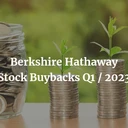Tags: Float
This fanpage is not officially affiliated with Berkshire Hathaway: Disclaimer
Embark on a captivating journey through Berkshire Hathaway's historic success story, unveiling the hidden gem that is its float. Discover how Warren Buffett's strategic genius and the company's adept use of the float have transformed it into a financial powerhouse. Dive into the intricacies of float calculation, historical insights, and regulatory challenges that shape Berkshire Hathaway's path to continued growth and profitability. Join us in unraveling the mysteries behind Berkshire Hathaway's unparalleled success, and witness the power of strategic investment in action. Shareholders of Berkshire Hathaway, buckle up for a thrilling ride through the world of finance and investment!

Introduction
Berkshire Hathaway, under the legendary leadership of Warren Buffett, known as the "Oracle of Omaha," stands as a paragon of investment success and business acumen. This conglomerate, with its vast portfolio spanning various industries, has consistently demonstrated the power of strategic investment and financial foresight. Central to its business model, and a key ingredient to its success, is the concept of 'float'—a term that, while common in the insurance industry, has been uniquely leveraged by Berkshire Hathaway to fuel its growth and profitability. The float has enabled Berkshire Hathaway to invest in iconic companies like Coca-Cola and American Express, turning these investments into monumental success stories 2↗.
The importance of float in the insurance world cannot be overstated. It represents the funds that an insurance company has at its disposal, temporarily, between the time premiums are collected and claims are paid out. This pool of capital serves as an interest-free loan, which, if utilized wisely, can significantly amplify an insurer's earning potential 3. Berkshire Hathaway's adept use of its float has been nothing short of masterful, transforming it from a textile manufacturing company into a global conglomerate.
To fully appreciate the strategic value of Berkshire Hathaway's float, it is essential to delve into the mechanics of how insurance companies generate and utilize these funds and to understand the historical evolution of insurance and the concept of float. The journey of insurance, from ancient risk distribution practices to the sophisticated economic mechanisms of today, provides a rich backdrop to this discussion 6. This article aims to unravel the complexities of Berkshire Hathaway's float, weaving together historical, economic, and political insights for a comprehensive understanding of its role in the company's unparalleled success story.
Understanding Float
In the insurance industry, 'float' refers to the difference between premiums collected and claims paid out. This concept is markedly different from the banking system's definition of float, which involves the double-counting of money within the banking system due to time gaps in registering a deposit or withdrawal 5. For insurers like Berkshire Hathaway, float acts as an interest-free loan. The premiums are collected upfront, and claims are paid out at a later date. This interim period allows the company to invest the float in high-return assets, significantly enhancing its earning potential without incurring the cost of interest 3.
The historical significance of float in the insurance industry is profound. Methods for transferring or distributing risk, the foundational principle behind insurance, have been practiced since the 3rd and 2nd millennia BC by Chinese and Indian traders. The general average principle of marine insurance, established by the Phoenicians on the island of Rhodes, and the direct insurance of sea-risks in Belgium around 1300 AD, are early examples of risk distribution mechanisms that laid the groundwork for modern insurance practices 6. These ancient practices underscore the enduring importance of managing financial risk through collective pooling of resources, a principle that remains at the heart of insurance today.
Warren Buffett's strategic use of float has been instrumental in transforming Berkshire Hathaway into the conglomerate it is today. By investing a portion of the float in stocks and entire companies, Buffett was able to achieve higher returns, thereby significantly increasing the company's wealth. This approach not only capitalized on the interest-free nature of the float but also leveraged the financial characteristics of the Property & Casualty (P/C) insurance business, which inherently operates on a collect-now, pay-later model 3.
The components that contribute to Berkshire Hathaway's float are multifaceted. According to the Annual Report 2023 ↗↗, these include unpaid losses and loss adjustment expenses, unearned premiums, and other policyholder liabilities. These figures, totaling $168,895 million in 2023, represent the vast pool of resources at Berkshire Hathaway's disposal for investment purposes 1. However, it is crucial to subtract figures such as deferred charges and insurance premiums receivable from the total float to arrive at a net figure available for investment.
Disciplined risk evaluation plays a pivotal role in ensuring that the float remains a beneficial asset rather than a liability. By maintaining a strong underwriting record and structuring insurance contracts to prevent immediate or near-term demands for significant sums of cash, Berkshire Hathaway has managed to keep its float cost-effective and stable over time 1. This disciplined approach, coupled with strategic investments, has allowed Berkshire Hathaway to leverage its float effectively, contributing significantly to its growth and profitability.
While technological advances have significantly reduced the banking system's float, they have not substantially impacted the insurance float. The nature of insurance transactions and the time lag between premium collection and claim payment ensure that the insurance float remains a stable and valuable financial resource. This stability and value have been key factors in Berkshire Hathaway's ability to use its float for high-return investments, further cementing its status as a financial powerhouse 5.

Components of Berkshire Hathaway's Float
The float of Berkshire Hathaway, a conglomerate overseen by the legendary investor Warren Buffett, represents a critical financial metric that has fueled its expansive growth ↗. To understand the components of Berkshire Hathaway's float, it is essential to dissect the various liabilities and assets that contribute to its calculation.
Liabilities Contributing to the Float
The liabilities that contribute to Berkshire Hathaway's float primarily consist of obligations related to its insurance operations. These include:
- Unpaid losses and loss adjustment expenses: Amounting to $111,082 million, these represent the estimated costs of claims that have occurred but have not been paid.
- Unpaid losses and loss adjustment expenses - retroactive reinsurance contracts: Valued at $34,647 million, these are specific to retroactive reinsurance contracts and represent liabilities for claims related to past events.
- Unearned premiums: Totaling $30,507 million, these premiums have been received but not yet earned, implying that the coverage period is still ongoing.
- Life, annuity, and health insurance benefits: These benefits, amounting to $20,213 million, are obligations to policyholders under life, annuity, and health insurance contracts.
- Other policyholder liabilities: Summing up to $11,545 million, these are additional liabilities to policyholders 1.
Assets and Recoverables to be Deducted
To calculate the net float accurately, certain assets and recoverables need to be deducted from the total liabilities. These include:
- Deferred charges - retroactive reinsurance: Amounting to $9,495 million, these are costs deferred due to retroactive reinsurance contracts.
- Insurance premiums receivable: Valued at $19,052 million, these are premiums due from policyholders.
- Reinsurance recoverables: Totaling $7,060 million, these are amounts due from reinsurance companies.
- Deferred policy acquisition costs: Approximately $4,600 million, these costs are related to the acquisition of new insurance policies 1.
The significance of each component in the overall calculation of the float lies in its impact on Berkshire Hathaway's financial flexibility and investment capacity. For instance, unpaid losses and unearned premiums represent significant future cash outflows, but until these obligations are settled, Berkshire Hathaway can utilize these funds. Conversely, assets and recoverables like insurance premiums receivable are deducted to provide a conservative estimate of the float, ensuring that the reported figure represents a net value that is realistically available for investment.
The impact of retroactive reinsurance contracts on the float is particularly noteworthy. These contracts allow Berkshire Hathaway to assume the risk of past insurance events, which adds complexity to the float calculation due to the uncertainty of these liabilities. Accounting for them separately ensures a more accurate representation of the float's components.
Calculation of Berkshire Hathaway's Float 2023
Calculating the float of Berkshire Hathaway involves a meticulous process that starts with aggregating the total liabilities contributing to the float and then subtracting the necessary assets and recoverables. The formula can be visualized as:
Float = Total Liabilities Contributing to Float - (Assets and Recoverables to be Deducted)
For 2023, the calculation is as follows, adapted from safemultiple.com7 with the values from the previous section:
-
Total Liabilities Contributing to Float: This includes unpaid losses and loss adjustment expenses ($111,082 million), unpaid losses and loss adjustment expenses - retroactive reinsurance contracts ($34,647 million), unearned premiums ($30,507 million), life, annuity, and health insurance benefits ($20,213 million), and other policyholder liabilities ($11,545 million). The sum of these figures is $207,994 million.
-
Assets and Recoverables to be Deducted: This category includes deferred charges - retroactive reinsurance ($9,495 million), insurance premiums receivable ($19,052 million), reinsurance recoverables ($7,060 million), and deferred policy acquisition costs ($4,600 million). The total deductions amount to $40,207 million.
-
Net Float for 2023: Subtracting the deductions from the total liabilities contributing to the float gives us a net float of $167,787 million.
You may play with the numbers to verify the calculation below with our brand new Berkshire Hathaway Float Calculator; refresh the page for 2023's default values:
| Berkshire Hathaway Float Calculator | Million $ |
|---|---|
| Liabilities - Contributors to Float | |
| Unpaid losses and loss adjustment expenses | |
| Unpaid losses and loss adjustment expenses - retroactive reinsurance contracts | |
| Unearned premiums | |
| Life, annuity and health insurance benefits | |
| Other policyholder liabilities | |
| Assets and Recoverables - to be subtracted from Float | |
| Deferred charges - retroactive reinsurance | |
| Insurance premiums receivable | |
| Reinsurance recoverables | |
| Deferred policy acquisition costs | |
| Total Float: | 167787 |
Note: while "Deferred charges - retroactive reinsurance" can be found in the assets of the balance sheet (K-70)1, the other numbers are found in the Notes to financial statements under "(1) Significant accounting policies and practices" as well as "(8) Other receivables". We may not re-print the pages here for copyright reasons.
🤔 However, there is a caveat. According to the annual report, the float is reported as $168,895 million 1. This discrepancy might be due to rounding or other minor components not found by me in the annual report. If you find the missing number(s), please let us know! Regardless, the calculated figure closely aligns with the reported float, underscoring the magnitude of funds available for Berkshire Hathaway to invest.
The significance of the 2023 float figure lies not only in its sheer size but also in what it represents for Berkshire Hathaway's overall financial health and investment capacity. With a growing trend over the years, this substantial float has enabled Berkshire Hathaway to invest in a diverse portfolio of companies and assets for long-term growth, embodying Warren Buffett's investment strategy of utilizing the "secret sauce" of insurance float for higher returns 2.
By meticulously calculating the float and understanding its components, stakeholders can appreciate the strategic advantage it provides Berkshire Hathaway, allowing it to maintain a dominant position in the market and continue its legacy of exceptional growth and investment success.

Historical Insights into the Float
The concept of insurance float is deeply rooted in the annals of financial history, tracing its origins back to ancient civilizations. The Phoenicians, renowned for their maritime prowess, contributed significantly to the development of marine insurance and established the general average principle around 1000 to 800 BC 6. This principle, which distributes the costs associated with the loss of cargo, marked the beginning of shared risk and collective financial security.
The inception of life insurance can be pinpointed to a policy made in London in 1583, underscoring the human desire to mitigate financial loss due to untimely death 6. Following the catastrophic Great Fire of London in 1666, the first fire insurance company, the "Insurance Office for Houses," was established by economist Nicholas Barbon in 1681, laying the groundwork for property insurance 6.
Edward Lloyd's coffee house, which opened in the late 1680s, became a crucial meeting place for those in the shipping industry seeking to insure cargoes and ships, eventually leading to the establishment of Lloyd's of London, a cornerstone of the modern insurance industry 6. The late 19th century saw the introduction of accident insurance, with the Railway Passengers Assurance Company pioneering this coverage in 1848 6.
The evolution of insurance from these historical milestones to government-initiated programs in the late 19th and early 20th centuries illustrates the growing recognition of insurance as a vital component of social and economic stability 6. These developments have profoundly influenced the modern insurance industry's management of float, a concept that Berkshire Hathaway has strategically harnessed to its advantage.
Berkshire Hathaway's adept use of float is not merely a testament to its financial acumen but also a reflection of the deep historical roots of insurance. By understanding and leveraging the time-tested principles of insurance, Berkshire Hathaway has turned the management of float into a formidable asset, underscoring the enduring relevance of these historical insights 3.
The Role of Float in Berkshire Hathaway's Investment Strategy
Warren Buffett, the "legendary investor" and "sage of Omaha," has long recognized the potential of insurance float as a pivotal resource for achieving higher returns on investments 2. The float, essentially an interest-free loan, is the difference between premiums collected and claims paid out. Buffett's epiphany that this pool of funds could be invested in stocks and private companies for substantial gains has been a cornerstone of Berkshire Hathaway's success.
The company's strategic investments in Coca-Cola and American Express in 1994 are prime examples of leveraging the float to secure positions in companies with strong business models poised for long-term growth 2. This approach has not only amplified Berkshire Hathaway's investment capabilities but also its market value and book value, which have grown at an impressive rate of ~20% per year since 1965 3.
A disciplined approach to risk evaluation is crucial in ensuring that the float remains a beneficial asset rather than a liability. By maintaining a strong underwriting record, Berkshire Hathaway ensures that its insurance operations do not demand immediate or near-term significant cash outlays, thus preserving the float's integrity and availability for investment 1.
Comparing Berkshire Hathaway's cost-free insurance float to the high-yield loans utilized by private equity firms and hedge funds, which often come with interest rates exceeding 7% per year, highlights the strategic advantage of Buffett's model 3. The company's ability to use the float as leverage for investments without the pressure of immediate cash demands has been instrumental in its success.
In essence, the float has been an extraordinary asset for Berkshire Hathaway, enabling it to make large-scale investments and achieve significant growth. This strategic use of float underpins the company's investment strategy, illustrating how a disciplined, innovative approach to financial management can yield remarkable results. Through the adept use of insurance float, Berkshire Hathaway has not only secured its position as a leading conglomerate but also redefined the potential of insurance premiums as a powerful investment tool 13.
Regulatory and Economic Considerations
The insurance sector, as a cornerstone of financial stability and risk management, operates within a framework of stringent regulatory oversight ↗. This highly regulated nature serves as both a safeguard and a challenge for companies managing substantial floats, like Berkshire Hathaway. Understanding the intricate dance between compliance and strategic float management is crucial for grasping the full picture of Berkshire Hathaway's success.
The Shield of Regulation
Insurance companies are under constant scrutiny by regulatory bodies to ensure their operations protect policyholders and maintain market stability. These regulations cover a broad spectrum, from solvency criteria to underwriting procedures, and aim to prevent discrimination, ensure fair competition, and safeguard against financial instability 4. For Berkshire Hathaway, navigating these regulatory waters is a daily reality. The company's ability to maintain a stable and beneficial float heavily relies on its compliance with these regulations. Compliance not only ensures the float's viability as a financial asset but also secures Berkshire's reputation as a reliable and ethical market player.
Navigating Economic Fluctuations
The float, while a powerful tool for investment, is not immune to the broader economic environment. Changes in interest rates, for instance, can significantly impact the investment returns from float funds. A rising interest rate environment may enhance returns on fixed-income investments, whereas a falling rate scenario could squeeze margins 4. Berkshire Hathaway's strategic prowess in investing its float takes into account these economic fluctuations, ensuring that the company's investment capacity remains robust across different economic cycles.
Mitigating Risks
Berkshire Hathaway's insurance operations are meticulously structured to mitigate risks associated with regulatory changes and economic fluctuations. The company's insurance contracts are designed to prevent immediate or near-term demands for significant sums of cash, thereby maintaining a stable float even in volatile times 1. This strategic structuring, coupled with Warren Buffett's disciplined approach to risk evaluation, has enabled Berkshire to navigate regulatory and economic challenges successfully.
The Role of Regulators
Insurance regulators play a pivotal role in monitoring and ensuring the ethical management of the float. By setting financial solvency criteria and monitoring company practices, regulators ensure that insurance companies can cover claims while also preventing practices that could harm consumers or the market 4. For Berkshire Hathaway, adherence to these regulatory standards is not just about compliance; it's about leveraging the regulatory framework to reinforce the stability and reliability of its float.
Balancing Act
The balance between regulatory compliance and strategic investment is a delicate one. On one hand, strict adherence to regulations ensures the float's stability and ethical management. On the other, strategic investment decisions aim to maximize the benefits of the float, driving growth and profitability. Berkshire Hathaway's success in this balancing act is a testament to its deep understanding of the regulatory landscape and its adeptness at navigating economic fluctuations. By carefully managing its float within these constraints, Berkshire not only complies with regulatory requirements but also capitalizes on the opportunities these funds present.
The regulatory and economic considerations surrounding Berkshire Hathaway's management of its float are complex and multifaceted. The company's ability to thrive in this environment is a testament to its strategic acumen, regulatory compliance, and economic foresight. As Berkshire continues to navigate these waters, its float remains not just a financial asset but a symbol of its enduring stability and growth potential in the face of regulatory and economic challenges.

Conclusion
Berkshire Hathaway's float stands as a cornerstone of its unparalleled success story, underpinning its growth, profitability, and strategic investments. The calculated float for 2023, totaling $168,895 million, reflects the vast pool of resources available to Berkshire Hathaway for high-return investments and long-term growth opportunities. By leveraging the interest-free nature of the float and maintaining a disciplined approach to risk evaluation, Berkshire Hathaway has transformed its insurance operations into a powerful asset for investment.
The historical evolution of insurance and float management provides a rich backdrop to Berkshire Hathaway's strategic use of the float ↗. From ancient risk distribution practices to the sophisticated economic mechanisms of today, the enduring principles of managing financial risk through collective pooling of resources have shaped Berkshire Hathaway's success.
Regulatory compliance and economic considerations play a crucial role in ensuring the stability and viability of Berkshire Hathaway's float. By navigating the complex regulatory landscape and adapting to economic fluctuations, Berkshire Hathaway has maintained its position as a market leader while maximizing the benefits of its float for strategic investments.
Warren Buffett's visionary approach to utilizing the float as a strategic investment tool has been instrumental in Berkshire Hathaway's success. By investing in iconic companies like Coca-Cola and American Express, Buffett has demonstrated the power of leveraging the float for long-term growth and profitability.
As shareholders of Berkshire Hathaway, it is essential to appreciate the strategic value of the float and its role in driving the company's enduring success. By understanding the components, calculation, and historical insights into the float, stakeholders can gain a deeper appreciation of Berkshire Hathaway's business model and investment strategy.
In the words of Warren Buffett, "Our float has grown from $147 billion to $164 billion in 2022. It's been an extraordinary asset for us." - and even larger in 2023. This quote encapsulates the significance of the float in Berkshire Hathaway's success story, highlighting its transformative impact on the company's growth and investment prowess.
Looking ahead, Berkshire Hathaway's float remains a key driver of its future investment opportunities and growth potential. By continuing to leverage the float strategically, maintain regulatory compliance, and navigate economic fluctuations, Berkshire Hathaway is poised to uphold its legacy of exceptional success in the years to come. Shareholders can take pride in being part of a company that exemplifies the power of strategic investment and financial foresight, driven by the remarkable asset that is Berkshire Hathaway's float.
References
-
Annual Report 2023 - Balance sheet and further information in text - www.berkshirehathaway.com ↩↩↩↩↩↩↩↩↩
-
Warren Buffett’s Secret Sauce: Investing the Insurance “Float” - economistwritingeveryday.com ↩↩↩↩
-
The Insurance Float: the Secret Behind Warren Buffett’s Wealth - finmasters.com ↩↩↩↩↩↩↩
-
A Brief Overview of the Insurance Sector - www.investopedia.com ↩↩↩
-
Float: What It Is, How It Works, Calculation, and Example - www.investopedia.com ↩↩
-
What is Insurance Float? How its calculated? - www.safemultiple.com ↩











